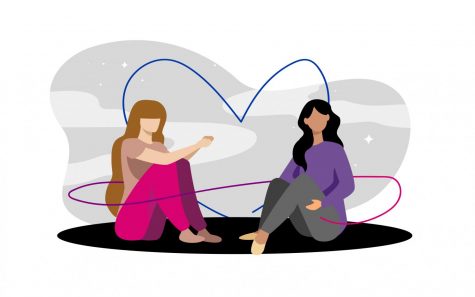Debunking the myths around asexuality and learning how to be an ally
March 1, 2021

For Paige Murphy, sex is something that never really interested her. As someone who identifies as panromantic-asexual, she said many of the more intimate aspects of a relationship like kissing or sex are things she completely forgets about.
A panromantic-asexual, like Murphy, rarely feels sexual attraction, but they can be romantically attracted to people of any gender.
Someone who identifies as asexual experiences little to no sexual attraction, while someone who identifies as aromantic feels no romantic attachment to other people. A person can be one or the other or both, and everyone’s experience identifying with these terms is unique to them.
Murphy, a senior production major, believes there is a common misconception that aromantic and asexual people express their identity and desires the same way.
“I wish more people understood that it’s a spectrum,” Murphy said. “It’s about having that conversation. … Just knowing that there are a bunch of different types of asexual people who like and dislike different things [is important]. It’s not just one type of person.”
In a 2019 Sky News poll, 1,119 adults were asked to define asexuality. Nearly 75% of participants defined it incorrectly or misconstrued it in some way, and almost half of the respondents were unsure of how to define it at all.
Gabby Bach, a sophomore journalism major, realized she was on the asexual spectrum when she was a sophomore in high school.
After discovering this, she looked to YouTubers like Jenna Clarek to find information on identifying as asexual and read books that made her feel represented, such as “The Diviners” by Libba Bray and “Let’s Talk About Love” by Claire Kann.
On Bach’s YouTube channel, she made a video discussing the underrepresentation of asexuality in the media and expressing the importance of people educating themselves on asexuality to better understand how the identity can differ from person to person.
“I think it’s difficult [for a lot of people] to wrap their mind around it in comparison to other sexualities, just because it’s not a fine line,” Bach said. “There are so many different variables that it feels very much [like] a personal experience, so when you say you identify on that spectrum, you have to go through and explain where you personally lie and what you’re comfortable with.”
Because asexuality is so commonly misunderstood, it is sometimes thought of as a mental illness or not a real sexual identity, she said.
“I just don’t let those things bum me out,” Bach said. “I know everything comes in time. When I’m ready for a relationship, I’ll find somebody, but I don’t want to force anything because I feel like I have to. It helps to have that reminder, rather than feeling like I have to fit some certain expectation.”
Bach said she wishes more people acknowledged that asexual people exist, which is helped by people educating themselves on what being asexual means.
To begin supporting the “ace” community, people can read about ace identities through resources like the Asexual Visibility and Education Network.
Yasmin Benoit, an English model, writer and activist for the asexual, aromantic and Black LGBTQ+ community, talks about ways people can be an ally to the aro/ace community in her article titled “Ditch the Label.”
“Be morally supportive. If you know someone who is coming to terms with their asexuality, listen to them and be encouraging, just as you would to someone who is coming out as gay or transgender,” Benoit writes. “Don’t be dismissive of their asexuality, or think that you know more about their bodies and their minds than they do.”
Bach says the best thing a person can do to support the aro/ace community is to be accepting of the identity and their peers.
“It’s just about being open minded,” Bach said. “Recognizing that person and their sexuality, and then being willing to ask them questions if they’re comfortable [with it].”







